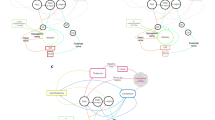Summary
In the context of aggression and courtship, Eigenmannia repeatedly interrupts its electric organ discharges (EODs) These interruptions (Fig. 1) contain low-frequency components as well as high-frequency transients and, therefore, stimulate ampullary and tuberous electroreceptors, respectively (Figs. 2, 3). Information provided by these two classes of receptors is relayed along separate pathways, via the electrosensory lateral line lobe (ELL) of the hindbrain, to the dorsal torus semicircularis (TSd) of the midbrain. Some neurons of the torus receive inputs from both types of receptors (Figs. 14, 15), and some respond predominantly to EOD interruptions while being rather insensitive to other forms of signal modulations (Figs. 12, 13). This high selectivity appears to result from convergence and gating of inputs from individually less selective neurons.
Similar content being viewed by others
Abbreviations
- CP :
-
central posterior thalamic nucleus
- Df :
-
frequency difference between neighbor's EOD and fish's own
- DPn :
-
dorsal posterior nucleus (thalamus)
- EOD :
-
electric organ discharge
- ELL :
-
electrosensory lateral line lobe
- JAR :
-
jamming avoidance response
- LMR :
-
lateral mesencephalic reticular formation
- nE :
-
nucleus electrosensorius
- nEb :
-
nucleus electrosensorius, beat-related area
- nE↑:
-
nucleus electrosensorius, area causing rise of EOD frequency
- nE↓:
-
nucleus electrosensorius, area causing fall of EOD frequency
- nEar :
-
nucleus electrosensorius-acusticolateralis area
- NPd :
-
nucleus praeeminentialis, pars dorsalis
- PPn :
-
prepacemaker nucleus
- PT :
-
pretectal nucleus
- SE :
-
nucleus subelectrosensorius
- TeO :
-
optic tectum
- TSd :
-
dorsal (electrosensory) torus semicircularis
- TSv :
-
ventral (mechano-sensory and auditory) torus semicircularis
References
Bastian J (1986) Electrolocation: Behavior, anatomy and physiology. In: Bullock TH, Heiligenberg W (eds) Electroreception. Wiley, New York, pp 577–612
Bennett MVL (1961) Modes of operation of electric organs. Ann New York Acad Sci 94:458–509
Bennett MVL, Obara S (1986) Ionic mechanisms and pharmacology of electroreceptors. In: Bullock TH, Heiligenberg W (eds) Electroreception. Wiley, New York, pp 157–181
Carr CE, Maler L (1985) A Golgi study of the cell types of the dorsal torus semicircularis of the electric fish Eigenmannia: functional and morphological diversity in the midbrain. J Comp Neurol 235:207–240
Carr CE, Maler L (1986) Electroreception in gymnotiform fish: Central anatomy and physiology. In: Bullock TH, Heiligenberg W (eds) Electroreception. Wiley, New York, pp 319–374
Carr CE, Heiligenberg W, Rose GJ (1986) A time-comparison circuit in the electric fish midbrain. I. Behavior and physiology. J Neurosci 6:107–119
Hagedorn M (1986) The ecology, courtship, and mating of gymnotiform electric fish. In: Bullock TH, Heiligenberg W (eds) Electroreception. Wiley, New York, pp 497–525
Hagedorn M, Heiligenberg W (1985) Court and spark: Electric signals in the courtship and mating of gymnotoid electric fish. Anim Behav 33:254–265
Heiligenberg W (1986) Jamming Avoidance Responses, model systems for neuroethology. In: Bullock TH, Heiligenberg W (eds) Electroreception. Wiley, New York, pp 613–649
Heiligenberg W (1991) Neural nets in electric fish. In: Computational Neuroscience Series. MIT Press (in press)
Heiligenberg W, Dye JC (1982) Labelling of electroreceptive afferents in gymnotoid fish by intracellular injection of HRP: The mystery of multiple maps. J Comp Physiol 148:287–296
Heiligenberg W, Rose G (1985) Phase and amplitude computations in the midbrain of an electric fish: Intracellular studies of neurons participating in the jamming avoidance response (JAR) of Eigenmannia. J Neurosci 5:515–531
Heiligenberg W, Keller CH, Metzner W, Kawasaki M (1991) Structure and function of neurons in the complex of the nucleus electrosensorius of the gymnotiform fish Eigenmannia: Detection and processing of electric signals in social communication. J Comp Physiol A 169:151–164
Hopkins CD (1973) Lightening as a background noise for communication among electric fish. Nature 242:286–270
Hopkins CD (1974) Electric communication. Functions in the social behavior of Eigenmannia virescens. Behaviour 50 (3–4): 270–305
Hopkins CD (1988) Neuroethology of electric communication. Annu Rev Neurosci 11:497–535
Horikawa K, Armstrong WE (1988) A versatile means of intracellular labeling: injection of biocytin and its detection with avidin conjugates. J Neurosci Methods 25:1–12
Johnston SA, Maler L, Tinner B (1990) The distribution of serotonin in the brain of Apteronotus leptorhynchus — an immunohistochemical study. J Chem Neuroanat 6:429–465
Kawasaki M, Heiligenberg W (1988) Individual prepacemaker neurons can modulate the pacemaker cycle of the gymnotiform electric fish, Eigenmannia. J Comp Physiol A 162:13–21
Kawasaki M, Maler L, Rose GJ, Heiligenberg W (1988) Anatomical and functional organization of the prepacemaker nucleus in gymnotiform electric fish: The accommodation of two behaviors in one nucleus. J Comp Neurol 276:113–131
Keller C (1988) Stimulus discrimination in the diencephalon of Eigenmannia: the emergence and sharpening of a sensory filter. J Comp Physiol A 162:747–767
Keller C, Heiligenberg W (1989) From distributed sensory processing to discrete motor representations in the diencephalon of the electric fish, Eigenmannia. J Comp Physiol A 164:565–576
Maler L, Ellis WG (1987) Inter-male aggressive signals in weakly electric fish are modulated by monoamines. Behav Brain Res 25:75–81
Metcalfe WK (1985) Sensory neuron growth cones comigrate with posterior lateral line primordial cells in Zebra fish. J Comp Neurol 238:218–224
Saunders J, Bastian J (1984) The physiology and morphology of two types of electrosensory neurons in the weakly electric fish Apteronotus leptorhynchus. J Comp Physiol A 154:199–209
Shumway CA (1989) Multiple electrosensory maps in the medulla of weakly electric gymnotiform fish. I. Physiological differences. J Neurosci 9:4388–4399
Zakon HH (1986) The electroreceptive periphery. In: Bullock TH, Heiligenberg W (eds) Electroreception. Wiley, New York, pp 103–156
Author information
Authors and Affiliations
Rights and permissions
About this article
Cite this article
Metzner, W., Heiligenberg, W. The coding of signals in the electric communication of the gymnotiform fish Eigenmannia: From electroreceptors to neurons in the torus semicircularis of the midbrain. J Comp Physiol A 169, 135–150 (1991). https://doi.org/10.1007/BF00215861
Accepted:
Issue Date:
DOI: https://doi.org/10.1007/BF00215861




